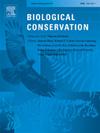Conservation implications of sex-specific daily movements of leopards: A global perspective
IF 4.9
1区 环境科学与生态学
Q1 BIODIVERSITY CONSERVATION
引用次数: 0
Abstract
Intraspecific variation in animal movements and its determinants may provide valuable knowledge about ecological and conservation needs of target species. Such studies are relevant to mammalian carnivores due to their wide-ranging behavior and high-profile conservation status. In this large-scale meta-analysis study, I explored the effects of various ecological and anthropogenic factors on daily distances moved by male and female leopards (Panthera pardus) across their global range in Africa and Asia. I tested eight hypotheses by running and ranking 35 linear regression models, separately for each sex. One best male model and two best female models, all statistically significant and having large effect sizes, were built upon 83 cases (45 cases of males and male groups and 38 cases of females and female groups) from 22 publications and 35 study areas. The analysis has shown that movements of male leopards are more intensive in less anthropogenically modified areas, and females move more actively in tropical and subtropical dry forests, shrublands, grasslands and open habitats. Designation and mapping of such areas may allow to delineate possible corridors, identify priority and most sensitive areas for linkages, and plan habitat restoration initiatives for leopard conservation. These results are particularly important for females whose lower mobility and philopatry are arguably among the most limiting factors of population connectivity in wild cats. Additionally, these results have implications for density estimation techniques, reduction of high mortality rates in males, and protection of even less suitable habitats for females.

求助全文
约1分钟内获得全文
求助全文
来源期刊

Biological Conservation
环境科学-环境科学
CiteScore
10.20
自引率
3.40%
发文量
295
审稿时长
61 days
期刊介绍:
Biological Conservation is an international leading journal in the discipline of conservation biology. The journal publishes articles spanning a diverse range of fields that contribute to the biological, sociological, and economic dimensions of conservation and natural resource management. The primary aim of Biological Conservation is the publication of high-quality papers that advance the science and practice of conservation, or which demonstrate the application of conservation principles for natural resource management and policy. Therefore it will be of interest to a broad international readership.
 求助内容:
求助内容: 应助结果提醒方式:
应助结果提醒方式:


